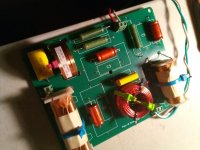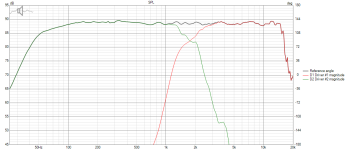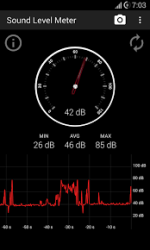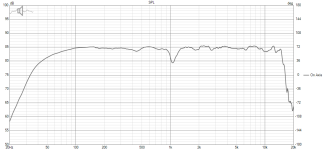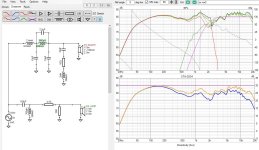Well, I had one more go at my sim anyway based on the extra info about your box. I also looked for a tweeter alternative to the RST28F and found the venerable Vifa/Peerless DX25 which hfc and heissmann and zaph have all tested favorably. It has a slightly lower resonant frequency than the Dayton, and though it has an on-axis bump at the far-end, its off-axis drops almost inversely, so I don't think it's a problem. We can then go for a slightly lower XO frequency of 1.9khz, and achieve a much better phase response and more benign impedance response, though I suppose it's no issue for your amps. All the files are in the zip but you need to download vituixcad to open the project up. I'll show you what mtg's woofer filter did to an ideal driver and the estimated spl and impedance response of the DS215 files I used in my sim. I still maintain his woofer filter is...weird. The bottom line is that the breakup of the DS215 is really rough for a 2-way; it's more suited as a woofer in a 3-way crossing way lower, frankly.

Attachments
Last edited:
From https://www.mtg-designs.com/diy-speaker-plans/flex-8/flex-8-ds
This is what the woofer filter is doing electrically, shown with an ideal driver:
This is what the woofer filter is doing electrically, shown with an ideal driver:
Then based on my guestimations for the DS215 response in your box, it would produce this acoustically. I don't think it's good. I'd choose instead any of the user submitted sims in this thread.

My bad, the file was saved in the projects directory and I forgot to copy it. The new zip also contains the enclosure/merger/diffraction tool projects files you need to modify them. Please note that the Minimum phase is activate in the drivers tab of the main program because there is a glitch at 3kHz in the wf phase curve.Ahh , sim for xovers !!!
Can't find OS.VXP ? that is - in the OS.zip file.
OS
For the simulation, give also a look at this doc by user @DcibeL
https://drive.google.com/file/d/1j9leycXJNvUmYZxQNVqg8U13mMRHh8Iw/view
Attachments
Last edited:
Perhaps that is wrong. Flex -8 (that 4th order LPF) was tweaked with the real speakers in a real room.Then based on my guestimations for the DS215 response in your box, it would produce this acoustically. I don't think it's good. I'd choose instead any of the user submitted sims in this thread.
That's why I did this - (below) , and just built the damn thing !!!!
I thought - how could things sound better with all those parts ?
Turned my speakers on ..... WOW !!!
Hearing all sorts of detailed imaged "ghost sounds".
Instrument placement is really different and detailed !
This driver did not sound like this with my simple 2nd order filters.
TOTALLY different sound - I like it!
The designer modified this 4th order for 6 different PE (cheap) drivers and
totally ACED it !
My dome tweeter might be padded down to much ... just a slight adjustment to 4K and up , mostly flat for music.
I lost 2 db output , too. 4th order might have losses,
Mids are more subdued and mellow .... Bass is better , too.
Very much more nicer to listen to - I'm happy.
Luckily , my amp is 2R stable and 70W/8R , I could still get 110db+ . This Xover
sucks 5% (loss) of total power.
I think these Xovers are worth 70-80 a pair (my cost). I did have to unwind (adjust) my big coil (4mH to 2.4mH)
and reused my 1mH (to .66mH) I overshot the big coil , just one layer dropped the 4 to 2.4mH ? ? Perhaps the Iron core
is different from the air core to calibrate mH's ?
Edit - that "faulty response" of the DS215 has a peak at 1K ... this is where the 215 has a dip ?
Correction ??
OS
Attachments
I'm glad you liked the result. My misgivings were based on the fact that they were using a compression driver with horn, so presumably the woofer filter is shaped to match that. The slope is steeper than 4th order - almost a brick wall - yet the tweeter filter is not going to blend normally with that if using a dome tweeter in terms of summing or phase. Perhaps you like the high amount of driver separation anyway. Deliberately sticking a peak in the response to manage the inherent dip in the driver...this would also be quite odd.
Last edited:
Yes , I am worried about that. The dome is way different from the Flex-8 horn/waveguide.yet the tweeter filter is not going to blend normally with that if using a dome tweeter in terms of summing or phase.
The compression driver in the original design is behind the woofer.
The dome at least sounds nice , I don't see how that "holographic" soundstage could be the result of some major
deficiencies.
This "FLEX-8" design leaves both of my Polks in the dust for SQ.
Right around the Xover (2050hz) , sounds quite sweet. I am not needing much EQ , like my other speakers.
I'm "relistening" to much music now , the DS-215-8 never sounded better - I've owned it for 15 years.
The original Mission 763i Xover had the big 2.5mH + 10uF for LPF , that sounded better than my 2nd order "experiment".
The full "FLEX-8" sound better than any Xover I've had yet , it REALLY puts my 2 POLK's to shame !!!
"driver separation" ?? like a gap at the Xover ? But I measure within a few db at 1K , 2K ,,, 3K. Tweeter is just a 2nd order ?
I have it Linkwitzed @ 2050hz? I don't hear any tone between 1-5Khz that is subdued ? EQ needed is nearly flat , just a slight
boost beyond 4K. I reduced my tweeter by 4db with the padding.
PS - I just heard it again .... a sound that just came out of the room somewhere ? None of my other speakers do this ?
Like getting headphone sound regardless of listening position - plus hearing sounds I've never heard (on my OEM's).
OEM's are just profit driven junk , POLK 1 (T15) has just a 1st order (cheap, cheap) , Polk monitor 40 has a simple 2nd order
with a reversed tweeter. T15 also have a reversed tweeter.
OS
OS
Last edited:
If it sounds good, it is good, some say. Without measurements, who knows what's going on?
I plugged in the original XO but simulating with the Dayton dome tweeter. Unadjusted, you'd get something like this.
Even if adjusting the level, this slope of the tweeter and overlap to the woofer is really not looking good.

I plugged in the original XO but simulating with the Dayton dome tweeter. Unadjusted, you'd get something like this.
Even if adjusting the level, this slope of the tweeter and overlap to the woofer is really not looking good.
I used to do this with dome tweeters, they can be most annoying.
One situation you might encounter is that a tweeter cuts in wide and hugs the baffle. Not only is there more power than the woofer is offering at it's top end, but diffraction can call more attention to the treble. I can't say for sure what effect this has for you, but it's level dependent and there is no proper electrical fix.
One situation you might encounter is that a tweeter cuts in wide and hugs the baffle. Not only is there more power than the woofer is offering at it's top end, but diffraction can call more attention to the treble. I can't say for sure what effect this has for you, but it's level dependent and there is no proper electrical fix.
But you have the padding for the flex-8 horn. I'm using (4.7R + 20R) instead of the flex-8 horn (10R +.9R). The designer padded the hellI plugged in the original XO but simulating with the Dayton dome tweeter.
out of the horn , as it has SPL of 107db. The Dome is 92db.
I figured the LPF had some losses , so dropped the dome down 4db. At least I won't blow it !
I only have a phone app that checks levels (below)...
1-3K seems to be within 2 db (even at 105db+). Phone mic sucks , just slightly accurate from 500-15K....
(below 2) is the flex -8 with the horn. Tweeter slope looks similar to a PE dome.
Phasing is right at the Xover point (2K) , no cancelling - down 3db 2K- and up. I might change the 4.7R to 2.7R to boost
the tweeter.
(below 3) is the actual DS-215 with that big dip at 1K. 1K is perfect on my actual speaker. I only hear it on the woofer , disconnect the
woofer , -15db on the dome only - hard to hear.
OS
Attachments
Last edited:
I was just illustrating what happens if you use the main filter (cap and coil) for a completely different driver.
If I plug in your resistor values for the l-pad, this is how it models.

Inverting either driver shifts the null to a wonky peak.
The biggest problem is the tweeter slope around 500hz and hump about 700hz; you only optimize/fix this by trying to complement the woofer slope; i.e. change the tweeter filter to 4th order or more and shift the tweeter crossover point higher.
If I plug in your resistor values for the l-pad, this is how it models.
Inverting either driver shifts the null to a wonky peak.
The biggest problem is the tweeter slope around 500hz and hump about 700hz; you only optimize/fix this by trying to complement the woofer slope; i.e. change the tweeter filter to 4th order or more and shift the tweeter crossover point higher.
Attachments
Can't explain that. Here a quick and dirty to my point about a steeper tweeter filter to complement the woofer filter. Phase and impedance not so bad.
If you have the parts, you may try it, but then you might as well look again through all the other sims submitted in the thread and pick another to also try.

Everything is made harder by using the PCB crossover designed for different drivers/tweeter to the one you actually own.
If you have the parts, you may try it, but then you might as well look again through all the other sims submitted in the thread and pick another to also try.
Everything is made harder by using the PCB crossover designed for different drivers/tweeter to the one you actually own.
Looks nice , don't have the parts or money to do a full 4th order on the tweeter !! WOW !
The simulation DOES show where I am compensating with my DSP ( 3K boost). Looks like the 2.2u/.66uH is the notch and the 1K dip compensation.
Close enough with the 2nd order (6.8u + .7uH) combo.
I bought the Flex-8 cause it was cheap and sold by the same dealer that I was buying parts from. He had just about the only build of
the DS-215-8 I could find on Google.
I was going to trash the whole speaker pair initially.
I bought a pair of polks , I was quite disappointed (they suck). Figured I might fix the DS215's.
Speakers are real rip-offs - either junk drivers or name brand "BS". Too expensive !!! 500-1000$ for any decent speakers ? WTF !
100-200$ OEM's are cheap China junk. My polks are 5$ Aliaba cheapo drivers with one cap for a Xover !!
I am listening to these speakers now - I can't stand the polks. They might end up in the junk (or a test pair for my amps...
OS
The simulation DOES show where I am compensating with my DSP ( 3K boost). Looks like the 2.2u/.66uH is the notch and the 1K dip compensation.
Close enough with the 2nd order (6.8u + .7uH) combo.
I bought the Flex-8 cause it was cheap and sold by the same dealer that I was buying parts from. He had just about the only build of
the DS-215-8 I could find on Google.
I was going to trash the whole speaker pair initially.
I bought a pair of polks , I was quite disappointed (they suck). Figured I might fix the DS215's.
Speakers are real rip-offs - either junk drivers or name brand "BS". Too expensive !!! 500-1000$ for any decent speakers ? WTF !
100-200$ OEM's are cheap China junk. My polks are 5$ Aliaba cheapo drivers with one cap for a Xover !!
I am listening to these speakers now - I can't stand the polks. They might end up in the junk (or a test pair for my amps...
OS
I wonder what level of accuracy the speaker models have versus the real world performance.
On amps , the semi models can deceive. Give good THD when the real amp sucks..
OS
On amps , the semi models can deceive. Give good THD when the real amp sucks..
OS
Just as spice that depends what you feed them. With real measurements in the actual box the simulation tools can give incredibly accurate results!what level of accuracy the speaker models have
The 2.5K dip is generated by the interference between W and T in 1-2K range, also you need to smooth the woofer peak at 1.5K and reduce the dip on the 500-1K caused by the LCR. You can add a resistor in series with first cap and increase the resistor of the LCR notch and then pad down the Tw as you like by adjusting the parallel resistor. The TW filter slope is LR4 acoustic.Final solution - below.
Weird , can't (real world) measure that 2.5-3K dip in the sim ??
OS
@motokok the wf coordinate should be negative unless the speaker is upside down.
- Home
- Loudspeakers
- Multi-Way
- Crossover question?
